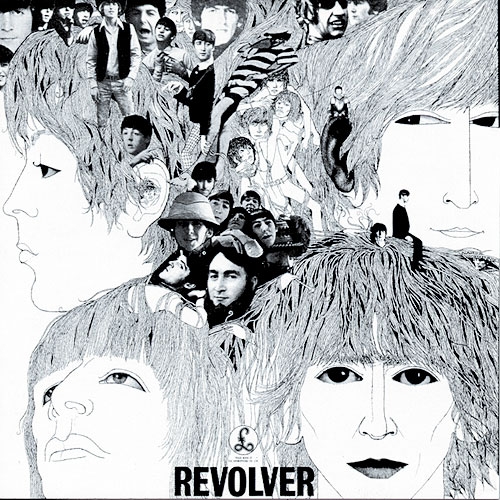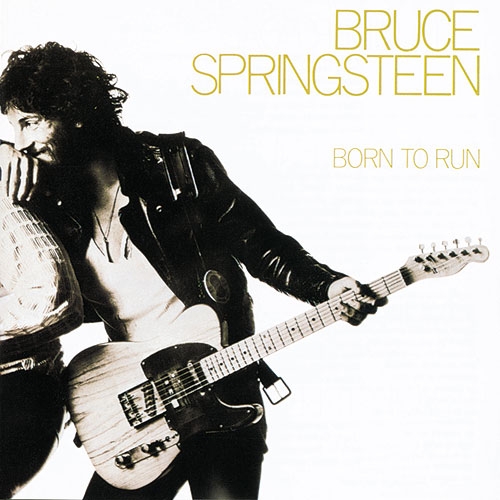In the age of the MP3, the album cover is really a lost art – which probably explains why 90 percent of the albums that readers selected come from the 1960s and the 1970s. Take a peek at the readers choice and at the inspirations behind the images. (Text by Andy Greene)
Number 1 – The Beatle’s Sgt. Pepper’s Lonely Hearts Club Band

The cover of the Beatles’ 1967 LP Sgt. Pepper’s Lonely Hearts Club Band is, without a doubt, one of the most iconic images in the history of rock & roll. The photo was originally going to show the Beatles (in their Sgt. Pepper’s outfits) playing in a park. That slowly evolved into the final concept, where they stand amidst cardboard cutouts of their heroes. The band originally planned on including Leo Gorcey, Gandhi, Jesus Christ and Adolf Hitler in the photo. Common sense kicked Hitler off the cover (though they did create an image of him), the still-lingering bitterness of Lennon’s “bigger than Jesus” comment kicked Jesus off the cover and Gandhi got the boot over concerns that India wouldn’t print the album.
Actor Gorcey requested $400 for his likeness, a decision he probably lived to regret. Mae West initially refused, asking “What would I be doing in a lonely hearts club band?” The Beatles sent her a letter explaining the concept, causing her to change her mind. The only people still living from the cover are Paul McCartney, Ringo Starr, Dion DiMucci, Shirley Temple and Bob Dylan.
Number 2 – Pink Floyd’s Dark Side of the Moon

Until Dark Side Of The Moon, Pink Floyd album covers hadn’t been very memorable. British design group Hipgnosis hadn’t done very good jobs with Floyd’s previous two albums, Obscured By Clouds and Meddle, but they had a good track record with other acts – and so the group hired them again in 1973 for Dark Side Of The Moon. “Rick Wright suggested we do something clean and graphic,” designer Storm Thorgerson told Floyd biographer Mark Blake. “Not photographic.” Their initial inspiration was a photo of a prism on top of some sheet music. It was black and white, but a color beam was going through it. Using that as a jumping off point, the team at Hipgnosis created the iconic cover.
Some stoner, college-age fans think that the rainbow is a hint that the album is synced to the Wizard of Oz. These people are the birthers of the rock community. No matter how much evidence proves they are wrong, they cling ever tighter to their belief.
Number 3 – Nirvana’s “Nevermind”
 Spencer Elden, the naked baby on the cover of Nirvana’s Nevermind, has a great pick-up line with the ladies: “Want to see my penis . . . again.” In 2007 interview with MTV, Elden said he feels weird about his bizarre role in history. “It’s kind of creepy that many people have seen me naked,” he said. “I feel like the world’s biggest porn star.” His parents were paid just $200 for the session, but Elden has been paid more than that a handful of times to recreate the famous photo. He wears a bathing suit for those, though.
Spencer Elden, the naked baby on the cover of Nirvana’s Nevermind, has a great pick-up line with the ladies: “Want to see my penis . . . again.” In 2007 interview with MTV, Elden said he feels weird about his bizarre role in history. “It’s kind of creepy that many people have seen me naked,” he said. “I feel like the world’s biggest porn star.” His parents were paid just $200 for the session, but Elden has been paid more than that a handful of times to recreate the famous photo. He wears a bathing suit for those, though.
Number 4 – The Beatles “Abbey Road”

Beatles nuts who believed that Paul McCartney died around 1967 and had been replaced by a dopplegänger found a lot to examine on the cover of Abbey Road. They saw the picture as a funeral procession: John (covered in white) is the preacher, Ringo (in black) is the mourner, George (in denim) is the gravedigger and Paul (barefoot) is the corpse. A license plate in the background read 281f. McCartney was 27 when the album came out, making people think the message meant he would have been 28 had he not died. None of that was intended. They shot the cover on August 8th, 1969 outside of Abbey Road studios. Tourists flock to the spot in droves, and it’s been parodied countless times – sometimes by members of the Beatles themselves, as Paul did on the cover of his 1993 LP Paul Is Live.
Number 5 – The Clash “London Calling”

Pennie Smith was snapping photos of the Clash at New York’s Palladium in September of 1979 when she captured one of the most iconic images in rock history. Paul Simonon was annoyed by the relatively quiet audience, so he began smashing his bass against the floor. “The Palladium had fixed seating, so the audience was frozen in place,” Simonon has said. “We weren’t getting any response from them, no matter what we did. I’m generally good-natured, but I do bottle things up and then I’m like a light switch, off and on, and it can be quite scary, even for me, when I switch, because it’s very sudden. Onstage that night I just got so frustrated with that crowd and when it got to the breaking point I started to chop the stage up with the guitar.”
Joe Strummer loved the photo, but Smith tried to convince him it was too out of focus for the London Calling cover. She was overruled. The smashed bass now resides at the Rock and Roll Hall of Fame in Cleveland, Ohio.
Number 6 – The Rolling Stones “Sticky Fingers”
The second album on our list designed by Andy Warhol, Sticky Fingers was the Rolling Stones’ first album for Atlantic Records – which gave them the freedom and budget to mass-produce this cover with an actual zipper. When unzipped, it revealed white underwear with the Rolling Stones’ tongue logo on it. Contrary to legend, the man in the underwear is not Mick Jagger. It’s one of Warhol’s associates, though nobody seems to be able to agree on exactly who it is.
Number 7 – The Beatle’s Revolver

German-born artist and musician Klaus Voorman was a longtime friend of the Beatles, and an obvious choice to draw the Revolver cover. The group played him their new track “Tomorrow Never Knows” before he sketched his first draft. “They were being so avant-grarde,” Voorman has said. “I thought the cover has to do the same thing. How far can I go? How surreal and strange can it be?”
He asked the Beatles to give him old photos of themselves, and he pasted some of them onto his own drawings. He had trouble with George Harrison’s face, so he pasted newspaper photos of eyes and lips onto it. For many years Voorman worried that the original was lost – but he claims to have recently tracked it down. “I’m not going to tell you where!” he said. “It’s well kept and looked after and I’m happy about that.”
Number 8 – Bruce Springsteen “Born to Run
 The cover of Bruce Springsteen’s Born To Run was shot by Eric Meola during just two and a half hours in June of 1975. “They came in at 10:00 a.m,” Meola recalled in a 2006 interview. “They were exhausted. They looked as if they’d been up all night . . . It was a statement about race as well. I wanted to capture on film what they did in concert. It is very hard to re-create that kind of energy. But to their credit, they did it.” During the final show of Springsteen and the E Street Band’s 2009 tour, Springsteen and Clarence Clemons recreated the classic pose in the middle of “Growin’ Up.” With Clemonscurrently recovering from a stroke, Meola’s photograph has taken on an added poignancy.
The cover of Bruce Springsteen’s Born To Run was shot by Eric Meola during just two and a half hours in June of 1975. “They came in at 10:00 a.m,” Meola recalled in a 2006 interview. “They were exhausted. They looked as if they’d been up all night . . . It was a statement about race as well. I wanted to capture on film what they did in concert. It is very hard to re-create that kind of energy. But to their credit, they did it.” During the final show of Springsteen and the E Street Band’s 2009 tour, Springsteen and Clarence Clemons recreated the classic pose in the middle of “Growin’ Up.” With Clemonscurrently recovering from a stroke, Meola’s photograph has taken on an added poignancy.
Number 9 – Pink Floyd “Wish You Were Here”

Hollywood stuntmen Ronnie Rondell and Danny Rogers worked on nearly 200 movies – including Speed, Titanic, Beverly Hills Cop, Bad Boys and Waterworld. They remain best known for a single photograph taken on the Warner Bros. backlot in 1975. For the cover of Wish You Were Here, Rondell wore a business suit over a flame retardant suit and shook Rogers’ hand while his clothing was on fire. To protect his head, Rondell wore a wig over a hood. Despite all the precautions, at one point during the shoot, the wind blew in the wrong direction and briefly spread the flames to Rondell’s moustache. The Warner Bros. lot where the photo was taken looks remarkably the same today.
Number 10 – The Velvet Underground “The Velvet Underground & Nico”

Andy Warhol got credit for producing the Velvet Underground’s 1967 debut LP, but his exact role in the creation of the album has always been a little murky. The cover, however, was entirely his project. Early versions of his famous banana print cover said “peel slowly and see,” and there was a peel-away banana sticker that revealed a pink banana underneath. With drug songs like “Heroin” and “I’m Waiting For The Man,” some have interpreted the album’s cover as a reference to the old schoolyard rumor that smoking a banana peel will get you high. Whether or not that was Warhol’s intent, the cover remains one of his most famous works.







